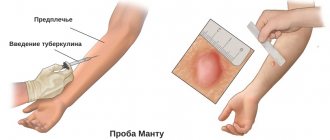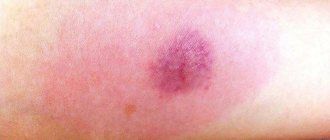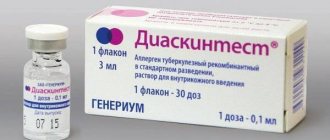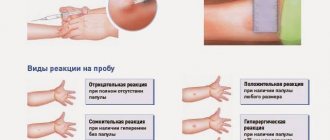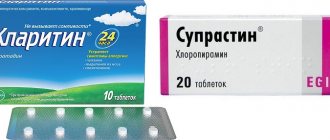Indications for Tuberculin vaccination
Tuberculin is used for tuberculin diagnostics (carrying out an intradermal Mantoux tuberculin test), which is an indicative diagnostic test for the purpose of:
- identifying the need for a patient to be vaccinated against tuberculosis with BCG
- diagnosis of tuberculosis;
- determining whether the population is infected with Mycobacterium tuberculosis (or the state of hypersensitivity to tuberculin, if the existing post-vaccination allergy does not give grounds to talk about infection).
The active substance of the drug (allergen-tuberculoprotein) causes, when performing an intradermal tuberculin test in people infected or vaccinated with BCG/BCG-M, a specific delayed-type hypersensitivity reaction in the form of a local reaction - hyperemia (redness) and infiltrate (papule formation).
Positive Mantoux reaction
If either a positive or hyperergic reaction to the administration of tuberculin occurs, the child should go to the doctor. Such diagnostic consequences indicate the following:
- the immune system is in the active phase of fighting the pathogen;
- Koch's bacillus is present in the body.
Knowing what a positive Mantoux test means in a child, you need to understand what signs and consequences you should be wary of.
Infection with mycobacteria and the presence of infection is indicated by:
- The appearance of papules at the site of tuberculin injection under the skin with normal reactions in previous times of the type of diagnosis.
- There is a significant difference between the papules of last year and the present. If the diameter of the latter is 6 millimeters greater than the same parameter of the previous one, you should start taking measures.
- The presence of a persistent and prolonged reaction to the introduction of tuberculin under the skin over a long period of time - from 3 to 5 years. An exception is made in cases where the consequences of the injection arise due to an allergy to the injected drug.
- The appearance of obvious signs of a hyperemic response on the skin. This is expressed in the appearance of red spots, which over time begin to accumulate pus.
- The appearance of a large infiltrate, the diameter of which exceeds 12 millimeters, with a very long history of BCG vaccination (more than 5 years).
Often, a positive Mantoux test reaction occurs in those patients who are at risk. These include people who have recently had contact with a patient with open tuberculosis. Also living in endemic areas of the disease. As well as those who have a low socio-economic status.
Anyone can get tuberculosis. This is not affected by financial situation or way of life. This is due to the fact that Koch's bacillus is resistant to irritants by mycobacteria. It can remain outside the human body in the environment for a long time. At the same time, its danger to the health of living beings remains. This pathogen spreads easily in crowded places, in hospitals, in transport, in educational institutions, in stores, etc.
A mosquito bite can lead to West Nile fever infection
Evaluation of Mantoux test results
The test result is assessed by a doctor or trained nurse 72 hours after the test. A reaction to tuberculin is possible in the form of hyperemia (redness of the skin) and the formation of a papule (a dense round area rising above the skin). Assessment of the Mantoux test consists of taking into account the size of the papule and assessing the severity of hyperemia. The measurement is carried out in a direction transverse to the axis of the hand, the result is taken into account in millimeters. Only the size of the papule is measured, and not the size of the area of hyperemia (redness). The size of the redness is taken into account only when the papule has not occurred.
Reaction options for the Mantoux test:
- negative - there are no changes on the skin;
- doubtful - there is redness of any size without a papule, or a papule no more than 2-4 mm;
- positive mild - papule size 5-9 mm;
- positive of medium intensity - papule size 10-14 mm;
- positive pronounced - papule size 15-16 mm;
- excessive (hyperergic) - the size of the papule exceeds 17 mm or there are pronounced signs of inflammation (reaction of the lymph nodes, skin ulceration, etc.).
- A negative Mantoux reaction indicates that the body does not have antibodies that are “familiar” with the tuberculosis bacterium. This means that the child is not infected, or there is no immune reaction to BCG vaccination.
- A questionable sample is considered negative.
- A positive test can be either a consequence of BCG vaccination or a sign of infection.
To assess the likelihood of infection, you need to look at the turn of the tuberculin test - the transition of a negative Mantoux reaction to a positive one (not associated with previous vaccination) or an increase in the diameter of the papule compared to the result of the previous test by 6 millimeters or more.
Also signs of infection are:
- hyperergic reaction;
- persistent (more than 4 years) persistent reaction with a papule of 12 mm or more;
- gradual (over several years) increase in sensitivity to tuberculin with the formation of an infiltrate measuring 12 mm or more.
A positive Mantoux test result without taking into account other diagnostic criteria is not a basis for making a diagnosis or starting any treatment.
Only a doctor can evaluate the reaction; if necessary, the child will be referred for additional examination to a TB specialist.
What is Mantoux test
The Mantoux test is a diagnostic procedure that is aimed at identifying tuberculosis infection, that is, Koch bacillus, in the human body. A healthcare professional injects a drug called tuberculin under the skin in the forearm area. It creates a certain tubercle, the condition of which must be checked 3 days (72 hours) after the injection.
In childhood, the Mantoux test is first prescribed at 1 year of age. This applies to cases where the child was vaccinated with BCG after birth. The reaction to the introduction of a vaccine allows us to evaluate how immunity is formed against a dangerous infectious disease - tuberculosis.
A positive reaction to Mantoux in childhood can be considered normal. Therefore, when analyzing the consequences of an injection, a number of factors should be taken into account. This concerns the patient’s medical history, the presence of other diseases, how long ago he was vaccinated with BCG, etc. At an older age, a positive reaction indicates infection with Koch’s bacillus. But this does not mean that the patient really has tuberculosis. He is a carrier of pathogenic microorganisms.
Indications for the Mantoux test
The Mantoux test is performed to diagnose tuberculosis.
Children vaccinated against tuberculosis:
The Mantoux test (Intradermal allergy test with tuberculin) is performed once a year, regardless of the results of previous tests, at the age of 1 to 7 years inclusive.
For children not vaccinated against tuberculosis (children who have not been vaccinated with BCG), the Mantoux test is performed 2 times a year starting at the age of 6 months
Children not vaccinated against tuberculosis:
The Mantoux test is performed - 2 times a year, starting from the age of 6 months, the Mantoux test is performed.
Classification of results
After tuberculin gets under the human skin, the Mantoux reaction begins to develop. It is characterized by the following parameters:
- diameter of hyperemia;
- skin problems (itching, irritation, etc.);
- button size;
- soreness;
- enlarged lymph nodes, etc.
The Mantoux test looks like a small bump that rises above the surface of the skin. After pressing on the injection site, it loses its reddish color and turns white.
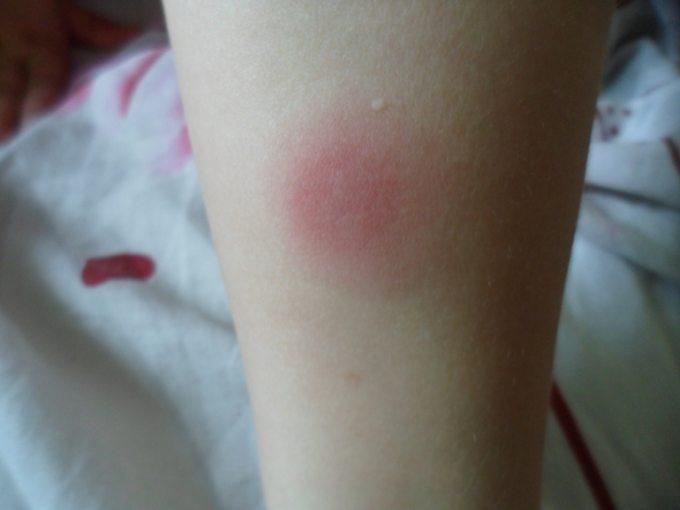
The following types of Mantoux reactions exist:
- Negative reaction. In this case, no changes can be detected on the skin at the site of tuberculin injection. Sometimes the puncture site may be noticeable, the diameter of which does not exceed even 1 millimeter.
- Questionable reaction. In this situation, you can notice with the naked eye a slight hyperemia of the skin, that is, redness at the site of tuberculin injection. In this case, no papular formation is noted. This means that there is no bump above the skin. Its maximum dimensions range from 2 to 4 millimeters.
- Positive reaction. The signs of trouble in this situation are clear and noticeable. The diameter of the papule exceeds 5 millimeters. At the same time, an infiltrated area is noted around the tubercle, the dimensions of which are even larger - up to 9 millimeters with a weakly expressed test. If the severity is average, then the diameter increases to 14 millimeters. The maximum reaction provokes changes in the skin, the magnitude of which reaches 16 millimeters.
- Hyperergic reaction. In this situation, the diameter of the infiltration area in children exceeds 17 millimeters, and in adults – 21 ml. In such cases, inflammatory reactions occur in the body. They can be quite serious. There is suppuration of the injection site, pain or significant enlargement of the lymph nodes.

The consequences of the Mantoux test depend not only on the presence of tuberculosis, but also on other factors. The reaction to the injection can be quite varied. Therefore, a person without education cannot evaluate the result of the examination. This should be done by a medical professional three days after the injection.
When not to worry
One of the biggest questions many parents have when vaccinating their children is what to do if Mantoux is positive. Not in all such cases there is a need to panic and worry. Sometimes such a reaction can be evidence of many aspects that are not always related to health problems.
You should not worry about the child’s condition in the following cases:
- In the complete absence of consequences of introducing tuberculin under the skin. In this situation, there is a high probability that in fact there are no Koch bacillus in the body. This means that tuberculosis cannot develop in the near future. Also, such a reaction may indicate the absence of any interactions with a previously administered BCG vaccination.
- When a small button is detected, the diameter of which does not exceed even 4 millimeters. Such parameters, in the complete absence of other signs, are normal. They say that the child is healthy, since he does not have tuberculosis infection.
- If a false positive reaction occurs. Questionable signs in some cases arise due to health problems not related to tuberculosis. You also need to notice damage to the injection site or the child’s consumption of foods related to popular allergens.
Popular Incubation period of influenza and its treatment in children

This is not a very common occurrence, but it does happen sometimes. It indicates that the body gave a certain reaction to the introduction of tuberculin under the skin, but the patient is not sick. All signs that appeared after the injection disappear after 2-3 weeks. No additional measures are required.
The frequency of false-positive reactions prompts many patients to the logical question of what such Mantoux consequences mean. They may be evidence that some other mycobacteria are present in the human body. Most often they are not as dangerous as Koch's wand.
Despite this, the doctor can still prescribe a not very strong course of anti-tuberculosis drugs as prevention and sanitation. This precaution applies to both adults and children. It is important to monitor the dosage, since these tablets affect, for example, the liver.
Separately, it is worth highlighting the occurrence of papules over 5 millimeters in children who had previously received a BCG vaccination. This reaction is normal and natural, so there is no need to worry in such cases. In addition, in the first years of life, the response to the introduction of tuberculin is often completely unpredictable. This is primarily due to the fact that the immune system is not fully formed.
Contraindications
Only a doctor can decide whether the drug “Tuberculin” is suitable for testing for tuberculosis.
“Tuberculin” is contraindicated for persons with allergic and autoimmune diseases!
The use of Tuberculin is also contraindicated in the following cases:
- common skin diseases
- epilepsy
- acute, chronic infectious and somatic diseases during exacerbation; allergic conditions (rheumatism in acute and subacute phases, bronchial asthma, idiosyncrasies with pronounced skin manifestations during exacerbation).
It is not allowed to carry out the Mantoux test in those children's groups where there is a quarantine for childhood infections. The Mantoux test is performed 1 month after all clinical symptoms disappear or immediately after quarantine is lifted.
Possible side effects
- For most, the test process is asymptomatic.
- Headaches may rarely occur
- General weakness, sleep disturbances, and increased body temperature rarely develop.
- Individuals with altered reactivity experience allergic reactions.
- Considering the possibility of developing immediate allergic reactions (anaphylactic shock, Quincke's edema, urticaria) in particularly sensitive individuals, vaccinated persons must be provided with medical supervision for 30 minutes.
Come get vaccinated at VIRILIS. A full range of vaccines for children and adults, family vaccinations - at a special price!
